



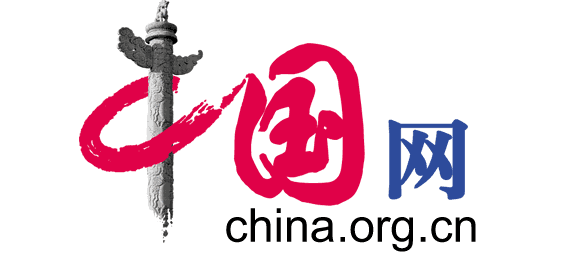

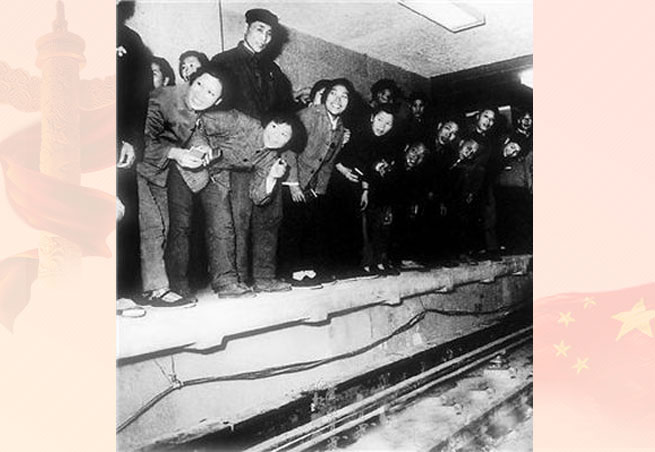 1On October 1, 1969, Phase I of the Beijing subway project was completed. Construction of China's first subway-the Beijing subway-started on July 1, 1965, with Phase I spanning 17 stations and running 23.6 km from Beijing Railway Station to Pingguoyuan of Shijingshan.
1On October 1, 1969, Phase I of the Beijing subway project was completed. Construction of China's first subway-the Beijing subway-started on July 1, 1965, with Phase I spanning 17 stations and running 23.6 km from Beijing Railway Station to Pingguoyuan of Shijingshan.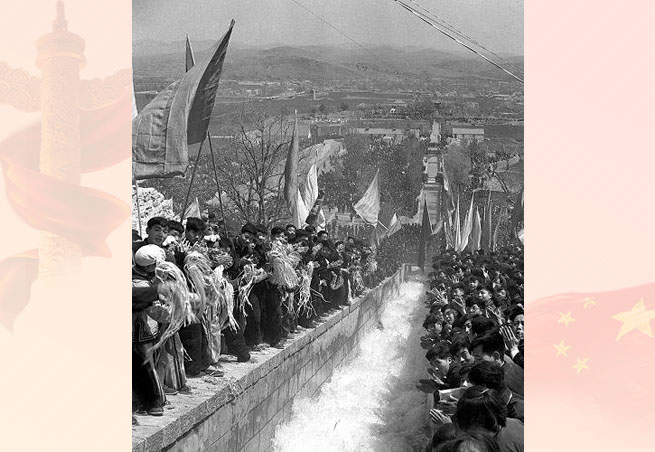 2The Red Flag Canal (Hongqi Canal) was completed in Linxian, Henan, on July 8, 1969. Construction on the 104 km canal began in 1960, expanding Linxian's irrigation area from less than 10,000 mu to 600,000 mu (15 mus are equal to 1 hectare).
2The Red Flag Canal (Hongqi Canal) was completed in Linxian, Henan, on July 8, 1969. Construction on the 104 km canal began in 1960, expanding Linxian's irrigation area from less than 10,000 mu to 600,000 mu (15 mus are equal to 1 hectare).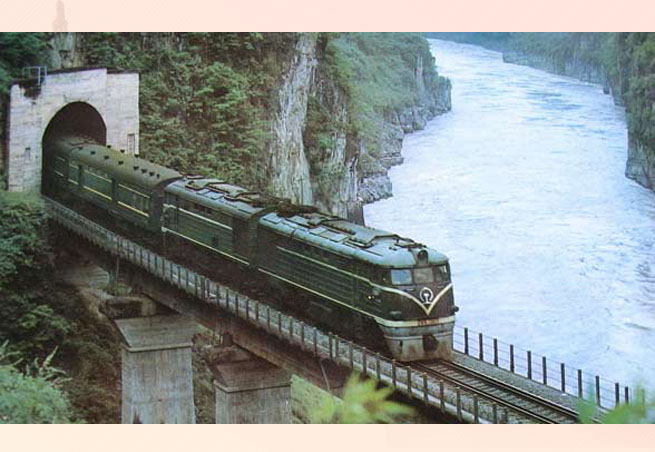 3Construction of the Chengdu-Kunming Railway, totaling a length of 1,090 km, started in 1958, was completed in July of 1970 and went into operation in the December of the same year. The builders also constructed 427 tunnels with an entire length of 345 km and erected 991 bridges along the line. The railway formed a communications artery in China's southwest region and proved helpful to resource exploitations in southwest China.
3Construction of the Chengdu-Kunming Railway, totaling a length of 1,090 km, started in 1958, was completed in July of 1970 and went into operation in the December of the same year. The builders also constructed 427 tunnels with an entire length of 345 km and erected 991 bridges along the line. The railway formed a communications artery in China's southwest region and proved helpful to resource exploitations in southwest China.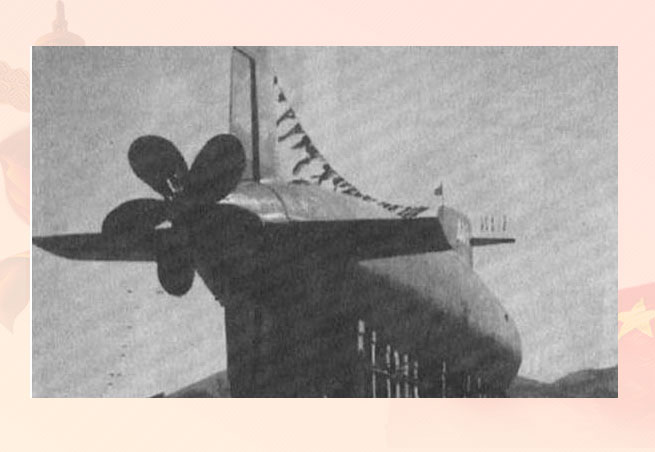 4China's first land-based nuclear submarine equipment became fully operational on July 30, 1970. On December 26, 1970, China's first nuclear submarine was launched and started its sea trial in August of 1971. It formally entered the PLA Navy service in August 1974, thus allowing China to become the fifth country in possession of a nuclear submarine.
4China's first land-based nuclear submarine equipment became fully operational on July 30, 1970. On December 26, 1970, China's first nuclear submarine was launched and started its sea trial in August of 1971. It formally entered the PLA Navy service in August 1974, thus allowing China to become the fifth country in possession of a nuclear submarine.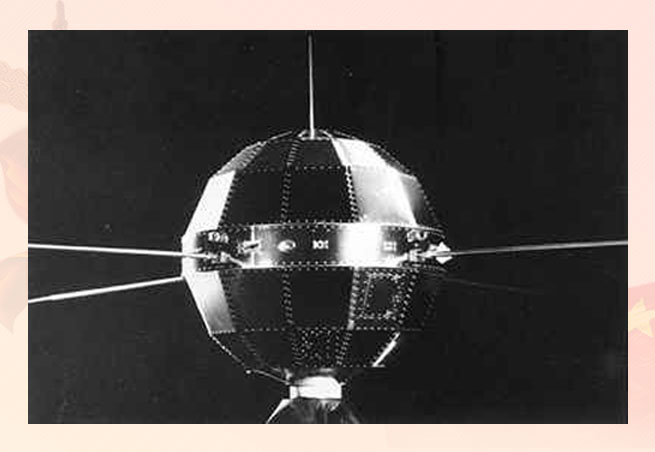 5On April 24, 1970, China successfully launched its first man-made space satellite. It had a mass of 173 kg and its closest distance to Earth was 439 kilometers while 2384 kilometers was the furthest, with a full orbital revolution once every 114 minutes.
5On April 24, 1970, China successfully launched its first man-made space satellite. It had a mass of 173 kg and its closest distance to Earth was 439 kilometers while 2384 kilometers was the furthest, with a full orbital revolution once every 114 minutes.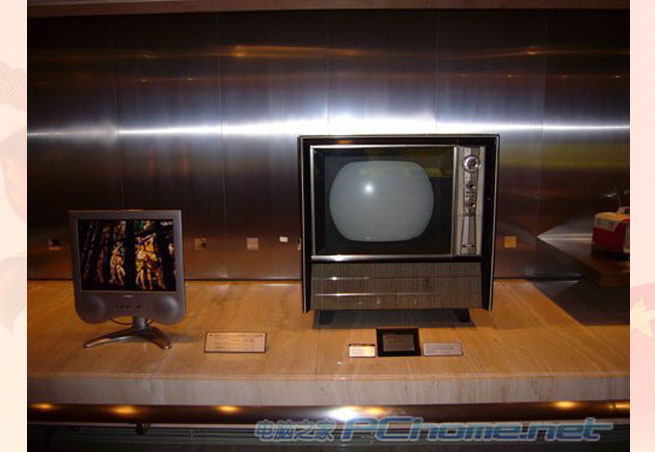 6China's first color TV set was produced in Tianjin on December 26, 1970, marking the start of China's history in color TV set production.
6China's first color TV set was produced in Tianjin on December 26, 1970, marking the start of China's history in color TV set production.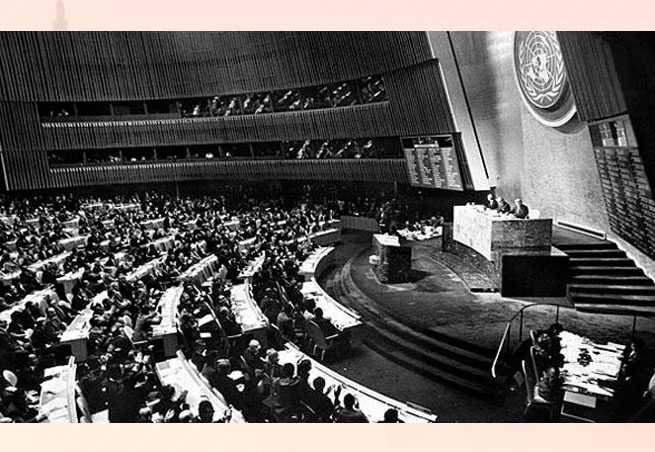 7On October 25, 1971, the 26th UN General Assembly decided to restore China's legal status in the United Nations while simultaneously expelling the Chiang Kai-shek group. China's delegation to attend the assembly was formed on November 2.
7On October 25, 1971, the 26th UN General Assembly decided to restore China's legal status in the United Nations while simultaneously expelling the Chiang Kai-shek group. China's delegation to attend the assembly was formed on November 2.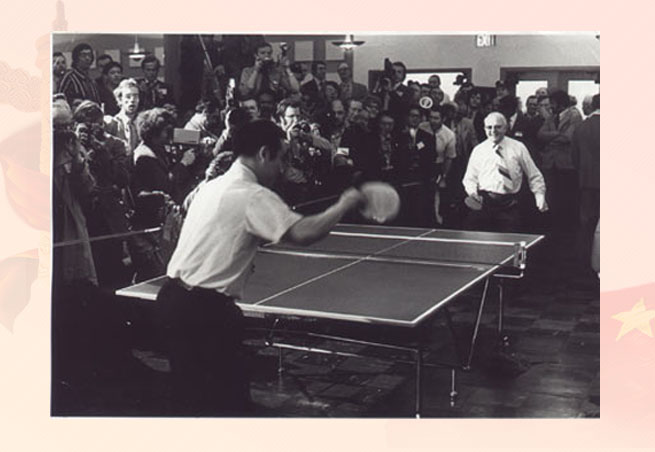 8On April 10, 1971, an American ping-pong team and a group of journalists became the first group of Americans allowed into China since the founding of the People's Republic of China in 1949. Chinese Premier Zhou Enlai met the ping-pong players at the Great Hall of the People in Beijing and said, "You have opened a new chapter in the friendly exchanges between Chinese and American peoples. I believe that the new beginning of friendship will be supported by most people of our two countries."
8On April 10, 1971, an American ping-pong team and a group of journalists became the first group of Americans allowed into China since the founding of the People's Republic of China in 1949. Chinese Premier Zhou Enlai met the ping-pong players at the Great Hall of the People in Beijing and said, "You have opened a new chapter in the friendly exchanges between Chinese and American peoples. I believe that the new beginning of friendship will be supported by most people of our two countries."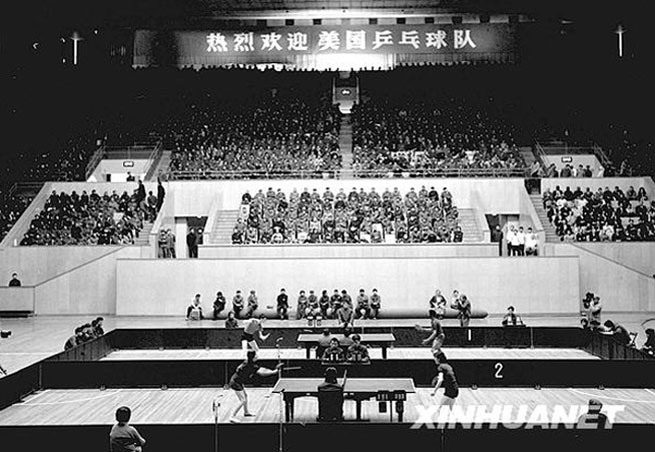 9Chinese and American ping-pong players play a friendly match at the Beijing Capital Gymnasium on April 13, 1971.
9Chinese and American ping-pong players play a friendly match at the Beijing Capital Gymnasium on April 13, 1971. 10US President Nixon's official visit to China spanned from February 21 to 28, 1972. On February 28, the two countries issued the Sino-US Joint Communique, which opened up the door of friendly exchanges between the two countries. To further enhance the friendly ties, the Chinese government sent two pandas, Xingxing and Lingling, as gifts for the American people.
10US President Nixon's official visit to China spanned from February 21 to 28, 1972. On February 28, the two countries issued the Sino-US Joint Communique, which opened up the door of friendly exchanges between the two countries. To further enhance the friendly ties, the Chinese government sent two pandas, Xingxing and Lingling, as gifts for the American people.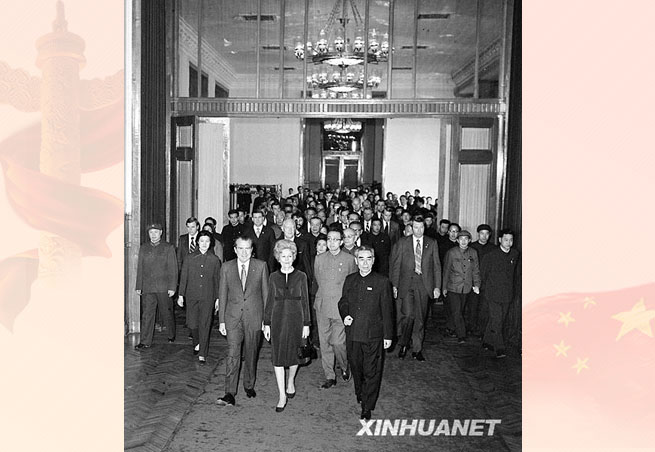 11On February 21, 1972, Chinese Premier Zhou Enlai held a banquet to welcome US President Nixon and his wife. In this photo, they are on the way to the banquet.
11On February 21, 1972, Chinese Premier Zhou Enlai held a banquet to welcome US President Nixon and his wife. In this photo, they are on the way to the banquet.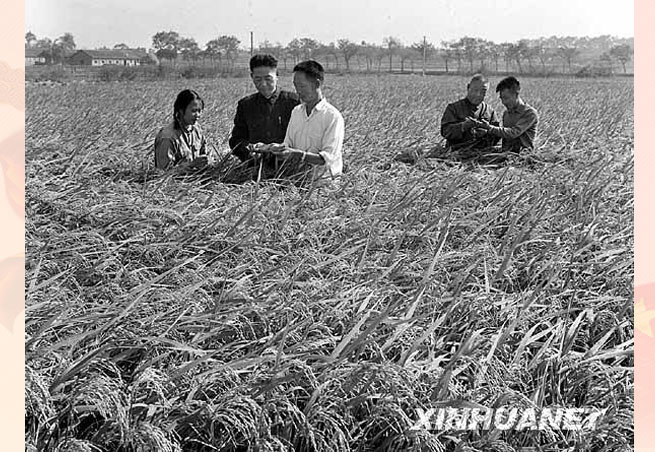 12In 1973, Chinese scientist Yuan Longping was able to cultivate and mass-produce a type of hybrid rice species after nine years of hard work. He was thus awarded China's first Principal Invention Award in 1981 and was internationally called the "Father of Hybrid Rice." The hybrid rice was highly praised by the world as "the second green revolution" and "magical oriental rice." This photo taken in November 1975 shows Yuan Longping (third from the right) observing how the rice was growing with his colleague Li Bihu (first from the right).
12In 1973, Chinese scientist Yuan Longping was able to cultivate and mass-produce a type of hybrid rice species after nine years of hard work. He was thus awarded China's first Principal Invention Award in 1981 and was internationally called the "Father of Hybrid Rice." The hybrid rice was highly praised by the world as "the second green revolution" and "magical oriental rice." This photo taken in November 1975 shows Yuan Longping (third from the right) observing how the rice was growing with his colleague Li Bihu (first from the right).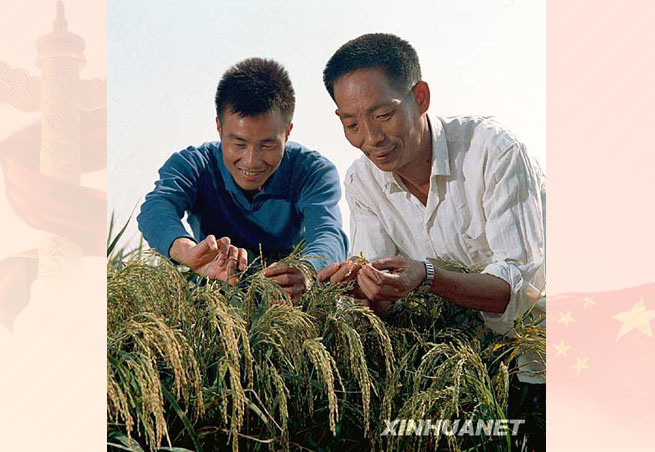 13Yuan Longping (right) studying how the rice was growing with his colleague Li Bihu in December 1976
13Yuan Longping (right) studying how the rice was growing with his colleague Li Bihu in December 1976 14Working site of No.3 Han Dynasty tomb in Mawangdui, Changsha, in August 1974. From 1972 to 1974, the No. 1, No. 2 and No. 3 tombs were successfully dug out in Mawangdui along Liuyang River. Over 3,000 precious relics of great historical and scientific value were found in the three tombs.
14Working site of No.3 Han Dynasty tomb in Mawangdui, Changsha, in August 1974. From 1972 to 1974, the No. 1, No. 2 and No. 3 tombs were successfully dug out in Mawangdui along Liuyang River. Over 3,000 precious relics of great historical and scientific value were found in the three tombs.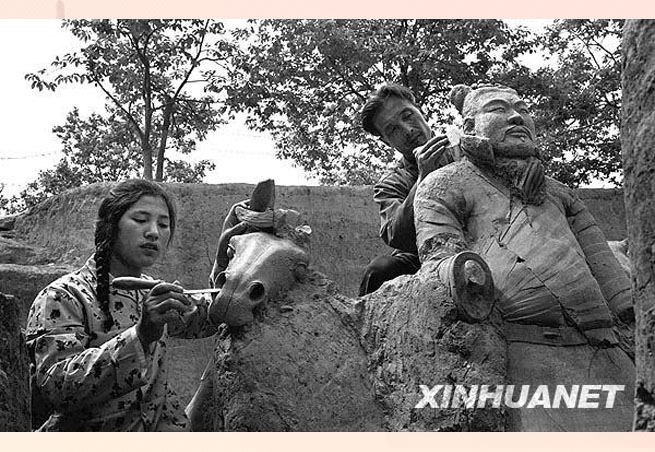 15Archeologists cleaning a pottery figure and horse in September 1975. On March 3, 1974, a farmer of Xiyang Village, which sat at the east of Emperor Qin's tomb, accidentally discovered several pieces of pottery figures and bronze weapons. Upon hearing of this matter, Zhao Kangmin, the person in charge of cultural relics in the Lintong County House of Culture, went to the place and stopped the well-digging work of the villagers. He then recovered the pieces that were already dug up and began the clean-up procedures for the site.
15Archeologists cleaning a pottery figure and horse in September 1975. On March 3, 1974, a farmer of Xiyang Village, which sat at the east of Emperor Qin's tomb, accidentally discovered several pieces of pottery figures and bronze weapons. Upon hearing of this matter, Zhao Kangmin, the person in charge of cultural relics in the Lintong County House of Culture, went to the place and stopped the well-digging work of the villagers. He then recovered the pieces that were already dug up and began the clean-up procedures for the site. 16The first electric railway from Baoji to Chengdu, the Baocheng line spanning 676 kilometers, opened for operation on July 1, 1975. In the photo is a home-made electric locomotive "Shaoshan" running on the Baocheng line.
16The first electric railway from Baoji to Chengdu, the Baocheng line spanning 676 kilometers, opened for operation on July 1, 1975. In the photo is a home-made electric locomotive "Shaoshan" running on the Baocheng line.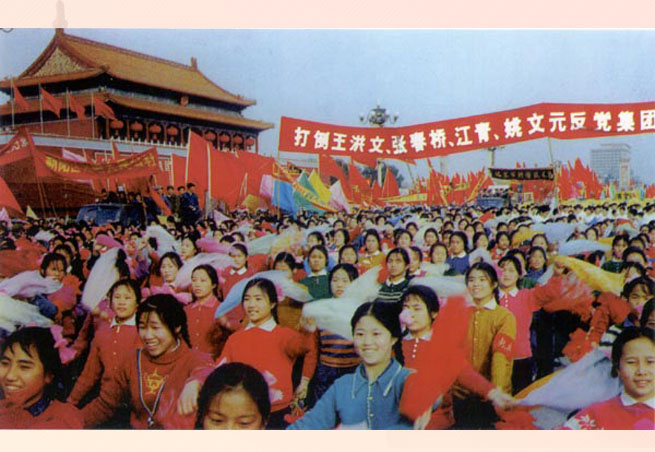 17Residents of Beijing celebrate at the Tian'anmen square after the "Gang of Four" members, Jiang Qing, Zhang Chunqiao, Wang Hongwen and Yao Wenyuan, were taken into custody and under investigation on October 6, 1976.
17Residents of Beijing celebrate at the Tian'anmen square after the "Gang of Four" members, Jiang Qing, Zhang Chunqiao, Wang Hongwen and Yao Wenyuan, were taken into custody and under investigation on October 6, 1976.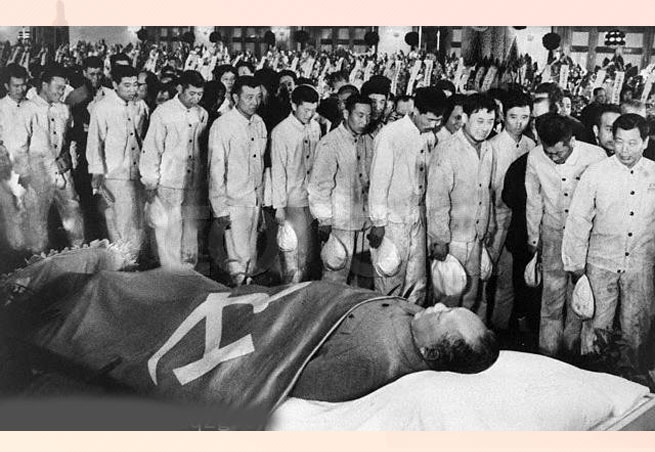 18Chairman of the CPC Central Committee and CPC Military Commission, and Honorary Chairman of the National Committee of the CPPCC Mao Zedong passed away at 00:10 a.m. on September 9, 1976, at the age of 83. The memorial meeting was held at Tian'anmen Square on September 18, with millions of people in attendance.
18Chairman of the CPC Central Committee and CPC Military Commission, and Honorary Chairman of the National Committee of the CPPCC Mao Zedong passed away at 00:10 a.m. on September 9, 1976, at the age of 83. The memorial meeting was held at Tian'anmen Square on September 18, with millions of people in attendance.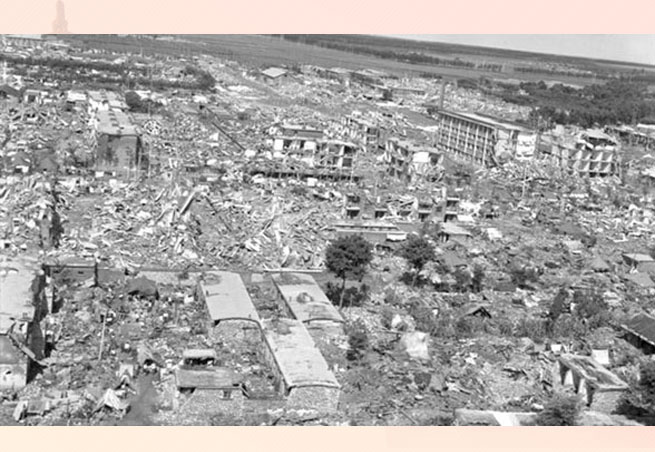 19A 7.8 magnitude earthquake hit the Tangshan-Fengnan area in Hebei Province on the morning of July 28, 1976, with effects also felt in Tianjin and Beijing. Tangshan was the center of the 47 square kilometer earthquake zone. Around 242,000 people died in the earthquake, 164,000 were badly injured and countless people were hurt. The first steps toward damage control began to take shape after over 20 days of diligent disaster relief. Due to previous disease prevention measures, Tangshan city was spared of any epidemic plagues.
19A 7.8 magnitude earthquake hit the Tangshan-Fengnan area in Hebei Province on the morning of July 28, 1976, with effects also felt in Tianjin and Beijing. Tangshan was the center of the 47 square kilometer earthquake zone. Around 242,000 people died in the earthquake, 164,000 were badly injured and countless people were hurt. The first steps toward damage control began to take shape after over 20 days of diligent disaster relief. Due to previous disease prevention measures, Tangshan city was spared of any epidemic plagues. 20From August 13 to September 25 in 1977, a recruiting meeting for higher education institutions based on Deng Xiaoping's ideas of reforming the recruiting systems of universities and colleges were held in Beijing. The participants discussed and formulated plans for the recruitment of undergraduate and graduate students. 5.7 million young people took the college entrance examination in 1977 and 273,000 were admitted (including the 62,000 freshmen in the first quarter of 1978).
20From August 13 to September 25 in 1977, a recruiting meeting for higher education institutions based on Deng Xiaoping's ideas of reforming the recruiting systems of universities and colleges were held in Beijing. The participants discussed and formulated plans for the recruitment of undergraduate and graduate students. 5.7 million young people took the college entrance examination in 1977 and 273,000 were admitted (including the 62,000 freshmen in the first quarter of 1978).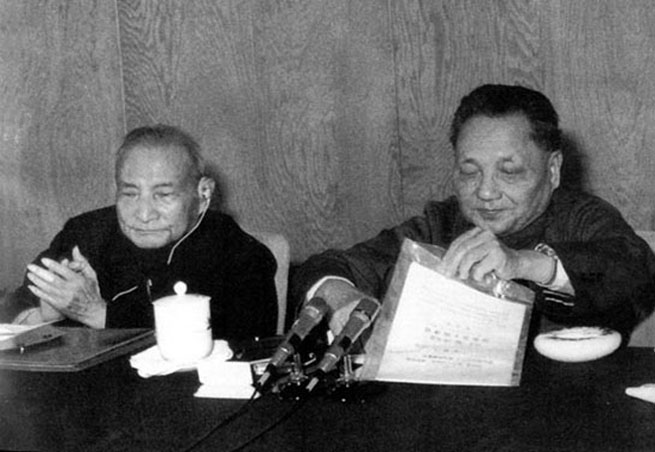 21The third plenary session of the 11th CPC Central Committee was held in Beijing from December 18 to 22, 1978. The main theme was to focus on constructing socialist modernization. The meeting marked the opening of a new chapter for China. This photo shows Deng Xiaoping (right) and Chen Chun at the meeting.
21The third plenary session of the 11th CPC Central Committee was held in Beijing from December 18 to 22, 1978. The main theme was to focus on constructing socialist modernization. The meeting marked the opening of a new chapter for China. This photo shows Deng Xiaoping (right) and Chen Chun at the meeting.
Comments